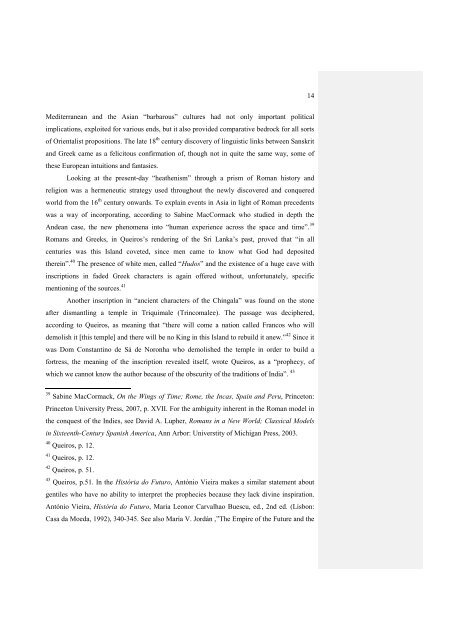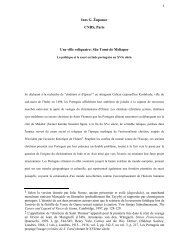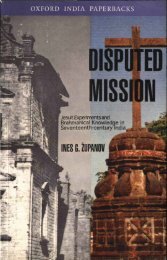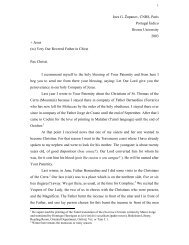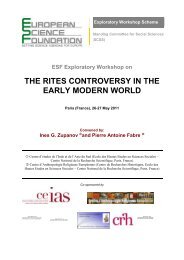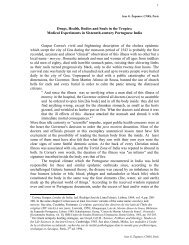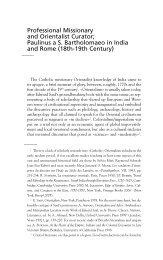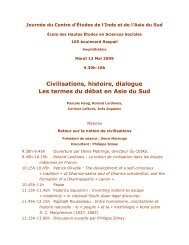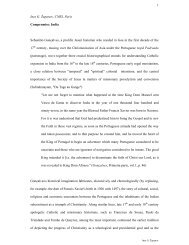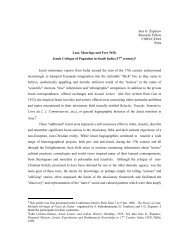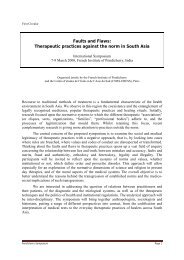Jesuit Orientalism; - Ines G. Županov
Jesuit Orientalism; - Ines G. Županov
Jesuit Orientalism; - Ines G. Županov
You also want an ePaper? Increase the reach of your titles
YUMPU automatically turns print PDFs into web optimized ePapers that Google loves.
14<br />
Mediterranean and the Asian “barbarous” cultures had not only important political<br />
implications, exploited for various ends, but it also provided comparative bedrock for all sorts<br />
of Orientalist propositions. The late 18 th century discovery of linguistic links between Sanskrit<br />
and Greek came as a felicitous confirmation of, though not in quite the same way, some of<br />
these European intuitions and fantasies.<br />
Looking at the present-day “heathenism” through a prism of Roman history and<br />
religion was a hermeneutic strategy used throughout the newly discovered and conquered<br />
world from the 16 th century onwards. To explain events in Asia in light of Roman precedents<br />
was a way of incorporating, according to Sabine MacCormack who studied in depth the<br />
Andean case, the new phenomena into “human experience across the space and time”. 39<br />
Romans and Greeks, in Queiros‟s rendering of the Sri Lanka‟s past, proved that “in all<br />
centuries was this Island coveted, since men came to know what God had deposited<br />
therein”. 40 The presence of white men, called “Hudos” and the existence of a huge cave with<br />
inscriptions in faded Greek characters is again offered without, unfortunately, specific<br />
mentioning of the sources. 41<br />
Another inscription in “ancient characters of the Chingala” was found on the stone<br />
after dismantling a temple in Triquimale (Trincomalee). The passage was deciphered,<br />
according to Queiros, as meaning that “there will come a nation called Francos who will<br />
demolish it [this temple] and there will be no King in this Island to rebuild it anew.” 42 Since it<br />
was Dom Constantino de Sá de Noronha who demolished the temple in order to build a<br />
fortress, the meaning of the inscription revealed itself, wrote Queiros, as a “prophecy, of<br />
which we cannot know the author because of the obscurity of the traditions of India”. 43<br />
39 Sabine MacCormack, On the Wings of Time; Rome, the Incas, Spain and Peru, Princeton:<br />
Princeton University Press, 2007, p. XVII. For the ambiguity inherent in the Roman model in<br />
the conquest of the Indies, see David A. Lupher, Romans in a New World; Classical Models<br />
in Sixteenth-Century Spanish America, Ann Arbor: Universtity of Michigan Press, 2003.<br />
40 Queiros, p. 12.<br />
41 Queiros, p. 12.<br />
42 Queiros, p. 51.<br />
43 Queiros, p.51. In the História do Futuro, António Vieira makes a similar statement about<br />
gentiles who have no ability to interpret the prophecies because they lack divine inspiration.<br />
António Vieira, História do Futuro, Maria Leonor Carvalhao Buescu, ed., 2nd ed. (Lisbon:<br />
Casa da Moeda, 1992), 340-345. See also María V. Jordán ,”The Empire of the Future and the


